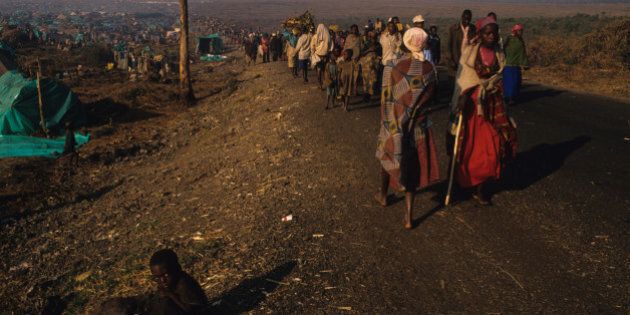
By Gavin Charles
Last week in Montreal, representatives from humanitarian civil society organizations and the Government of Canada gathered under the auspices of the Humanitarian Response Network for the official Canadian launch of new international guidelines for addressing gender-based violence (GBV) during humanitarian operations. The guidelines add definition and breadth to an ongoing global conversation about GBV. They also offer an opportunity to enhance, in this crucial and cross-cutting area, the relationship between immediate humanitarian relief and the longer-term development goal of equality.
Overall, the new guidelines are rooted in equality: equality of rights and needs among genders, and equality of responsibility among humanitarian responders.
The guidelines join a growing collection of international legal and policy actions explicitly or implicitly addressing elements of GBV. These include a range of soft and hard international humanitarian law, like the Geneva Conventions and Protocols; the Universal Declaration of Human Rights; the Convention against Torture; the Convention on the Elimination of all forms of Discrimination against Women; the Beijing Declaration and Platform for Action; UN Security Council resolutions, notably including Resolution 1325, and the associated National Action Plans; the Call to Action on Protection from Gender-Based Violence in Emergencies; and a recent international resolution through the summit of the International Conference of the Red Cross and Red Crescent.
The latest guidelines revise an initial set produced in 2005. The new version was prepared under the guidance of 16 leading international humanitarian organizations and UN agencies, through broad-based consultations including field visits, direct dialogue, and surveys with groups and individuals around the world. Compared with the previous version, the new guidelines are broader in both scope and orientation. They expand the emphasis beyond sexual violence to include other forms of physical and mental harm, or threats perpetrated based on social distinctions between men and women. They also expand the target audience beyond GBV specialists to all actors, mainstreaming action on GBV across all humanitarian sectors.
Overall, the new guidelines are rooted in equality: equality of rights and needs among genders, and equality of responsibility among humanitarian responders. They mandate and encourage all humanitarian actors to consider situational questions like the following:
•A woman in a refugee camp has to use the bathroom during the night. Will she be safe on the poorly-lit path to the toilet?
•After a natural disaster, youth attend a training program on health and hygiene. Will the agenda include sexual health and hygiene, and will the trainers include women?
•Amidst a conflict, a rape victim needs testing for HIV and other sexually transmitted infections. Will the doctor be accessible and affordable, the tests thorough, and the counselling robust?
•During a famine, people line up for food packages. Will women and men have equal and adequate access?
All societies have challenges with gender inequality, and GBV is not limited to humanitarian crises and emergency situations. But the risk and prevalence of GBV is exacerbated in emergency or conflict situations as people suffer displacement, separation from support networks, overcrowding, loss of documentation, the breakdown of social norms against violence, and other effects that increase vulnerability.
Successfully tackling GBV requires a holistic approach that addresses immediate needs of survivors (responding to GBV) and potential victims (mitigating the existence of GBV), while also supporting long-term change to increase equality (preventing GBV). Notably, only the responsive element requires specialized training. All humanitarians, and indeed policymakers and programmers more generally, should be aware of the importance and get involved in the process of mitigating and preventing GBV.
The guidelines help achieve this. They constitute a set of standardized, trans-sector recommendations designed to integrate awareness and action to prevent and mitigate GBV throughout humanitarian operations. The guidelines approach this process not as a distinct set of tasks but rather as a lens through which to view all humanitarian operations, on the basis that humanitarians should always plan and implement programming with the assumption that GBV is occurring in a given emergency setting.
In that vein, the guidelines are comprehensive, but not overly prescriptive; they establish an accessible and holistic pool of recommended actions for humanitarian workers to consider and implement, while leaving room for discretion regarding the priority and order of those actions on the basis of context-specific knowledge and judgment. The guidelines are intended as just that -- guides to help those working across the humanitarian sphere to ensure and broaden the inclusion of GBV interventions in their practice.
The guidelines help practitioners gain a better understanding of GBV. As noted above, they adopt a broad definition of violence, incorporating any form of harm perpetrated on the basis of gender. While the use of the terminology of violence can be debated - and was in Montreal - the intent is to ensure that systemic harms beyond physical violence are and tackled in humanitarian contexts.
The breadth of scope of the guidelines, and of the GBV phenomenon, means that many of the recommendations can be adapted and applied in non-emergency contexts. In this respect, the GBV guidelines are a useful reference point for longer-term development efforts; they can inform humanitarians in meeting the immediate needs of civilians, while also helping development practitioners to foster a socio-political culture that helps prevent GBV. Applying the guidelines throughout humanitarian and development efforts could help build linkages between the two fields that would improve continuity in programming and practice across the humanitarian-development spectrum, and thereby deliver more sustainable benefits to those receiving assistance.
Gavin Charles is a Policy Officer at the Canadian Council for International Co-operation.
The views expressed in this blog are those of the authors, and do not necessarily reflect the positions of CCIC or its members.
Follow HuffPost Canada Blogs on Facebook